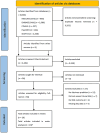Association between dizziness and future falls and fall-related injuries in older adults: a systematic review and meta-analysis
- PMID: 39293812
- PMCID: PMC11410394
- DOI: 10.1093/ageing/afae177
Association between dizziness and future falls and fall-related injuries in older adults: a systematic review and meta-analysis
Abstract
Background: Dizziness is common in older adults, especially in those attending falls services. Yet, the extent to which dizziness is associated with future falls has not been reviewed. This systematic review and meta-analysis assessed the association between dizziness and future falls and related injuries in older adults.
Methods: EMBASE, CINAHL Plus, SCOPUS and PsycINFO databases were searched from inception to 5 February 2024. The review was registered on PROSPERO (registration ID: CRD42022371839). Meta-analyses were conducted for the associations of dizziness with future falls (including recurrent and injurious falls). Three meta-analyses were performed on different outcomes: any-type falls (≥1 falls), recurrent falls (≥2 falls) and injurious falls.
Results: Twenty-nine articles were included in the systematic review (N = 103 306 participants). In a meta-analysis of 14 articles (N = 46 795 participants), dizziness was associated with significantly higher odds of any-type future falls (OR = 1.63, 95% CI = 1.44-1.84). In another meta-analysis involving seven articles (N = 5630 participants), individuals with dizziness also had significantly higher odds of future recurrent falls (OR = 1.98, 95% CI = 1.62-2.42). For both meta-analyses, significant overall associations were observed even when adjusted for important confounding variables. In contrast, a meta-analysis (three articles, N = 46 631 participants) revealed a lack of significant association between dizziness and future injurious falls (OR = 1.12, 95% CI = 0.87-1.45).
Conclusions: Dizziness is an independent predictor of future falls in older adults. These findings emphasise the importance of recognising dizziness as a risk factor for falls and implementing appropriate interventions.
Keywords: benign paroxysmal positional vertigo (BPPV); falls; older people; orthostatic hypotension; prospective; systematic review; vertigo.
© The Author(s) 2024. Published by Oxford University Press on behalf of the British Geriatrics Society.
Conflict of interest statement
S.W. is on a patent for a vestibular app called VestAid, and a paid consultant for the company that developed this app. She receives occasional honoraria for teaching for Interacoustics, a company that makes vestibular equipment. She teaches and receives payment from a company called Medbridge in the USA.
Figures




References
-
- Ganz DA, Latham NK. Prevention of falls in community-dwelling older adults. N Engl J Med 2020; 382: 734–43. - PubMed
-
- Kwan MM, Close JC, Wong AKWet al. . Falls incidence, risk factors, and consequences in Chinese older people: a systematic review. J Am Geriatr Soc 2011; 59: 536–43. - PubMed
-
- Hartholt KA, Beeck EF, Polinder Set al. . Societal consequences of falls in the older population: injuries, healthcare costs, and long-term reduced quality of life. J Trauma Acute Care Surg 2011; 71: 748–53. - PubMed
Publication types
MeSH terms
LinkOut - more resources
Full Text Sources
Medical

